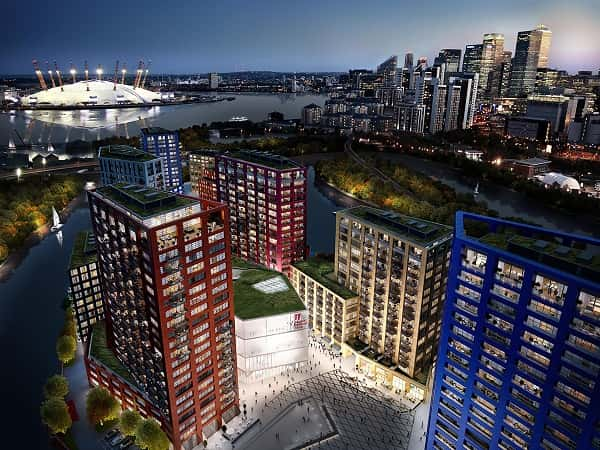
New developments spring up all the time, but its not often that you witness a community being built. Ballymore & Ecoworld’s London City Island is just that – a new community. Comprising 1,706 apartments, completing from mid 2016 all the way through to 2019, the scheme will also result in a new home for English National Ballet, 1,801 sqm of leisure space, 4,502 sqm for offices, 1,852 sqm of retail and 2,714 for the creative industry.
London City Island, or LCI for short, is designed around a mini-Manhattan concept according to the developer’s brochure, and having visited, both internally and externally, we believe that this concept has been executed. Although the buildings are undoubtedly ‘new’, there are nods to that warehouse-loft feel. Flat-fronted buildings with large windows, much higher-than-average ceiling height, strip wood flooring, Victorian-style radiators and butler sinks all combine to give a rather rustic impression.
Residents at London City Island are going to be well looked after. A 24/7 concierge has become somewhat the norm these days, but add to that a really quite splendid, and dare we say it cool residents lounge, an outdoor swimming pool, comprehensive leisure suite and landscaped gardens which are about as far away as an afterthought as you can get… we think LCI is a triumph.
Just one word of warning though. London City Island is NOT really on an island. Forget the dreams of rowing home, or taking a leather-lined launch to work, LCI is very much connected to the rest of London. Sure they’ve built a footbridge which, rather conveniently, connects you directly into Canning Town station, but you can also drive on and off at Orchard Place. The ‘island’ is created by the River Lea’s (almost closed) loop as it joins the Thames. Sorry!
Key Facts about London City Island
1,706 residential units, over 10 blocks
Developer: Ecoworld & Ballymore
Architects: Glenn Howells Architects
Anticipated completion: 2016 through to 2019
Nearest transport link: Canning Town station (Jubilee line & DLR)
Why would I want to live there?
Do you know what? We’d live there. Can’t give much higher praise than that can we.
We love the boldness of it. So much architecture is supposed to be bold these days, but we like things that nod to the past. We like a warehouse feel. It just happens that these warehouses are blue, white, black, orange or red. We like the fact it’s undoubtedly a community, and not just a building. We like the fact there was nothing on the ‘island’ before, so the scheme has added to London, and not taken away.
Its also incredibly well connected to the rest of London. For many, say “Canning Town”, and they say “where?”. But the reality is that London City Island is just next door to Canary Wharf. Canning Town station really is a ‘hub’ in the most traditional sense. You can get anywhere from Canning Town station. OK, nearly anywhere. Here’s some of the direct connections: Canary Wharf (4 mins), London Bridge (10 mins), Westminster (15 mins), Bond Street (20 mins), Stratford (7 mins) and London City Airport (7 mins).
Rental values at London City Island
Studios from £320 per week
1 bedroom apartments from £365 per week
2 bedroom apartments from £450 per week
Search our E14 Rental Properties

